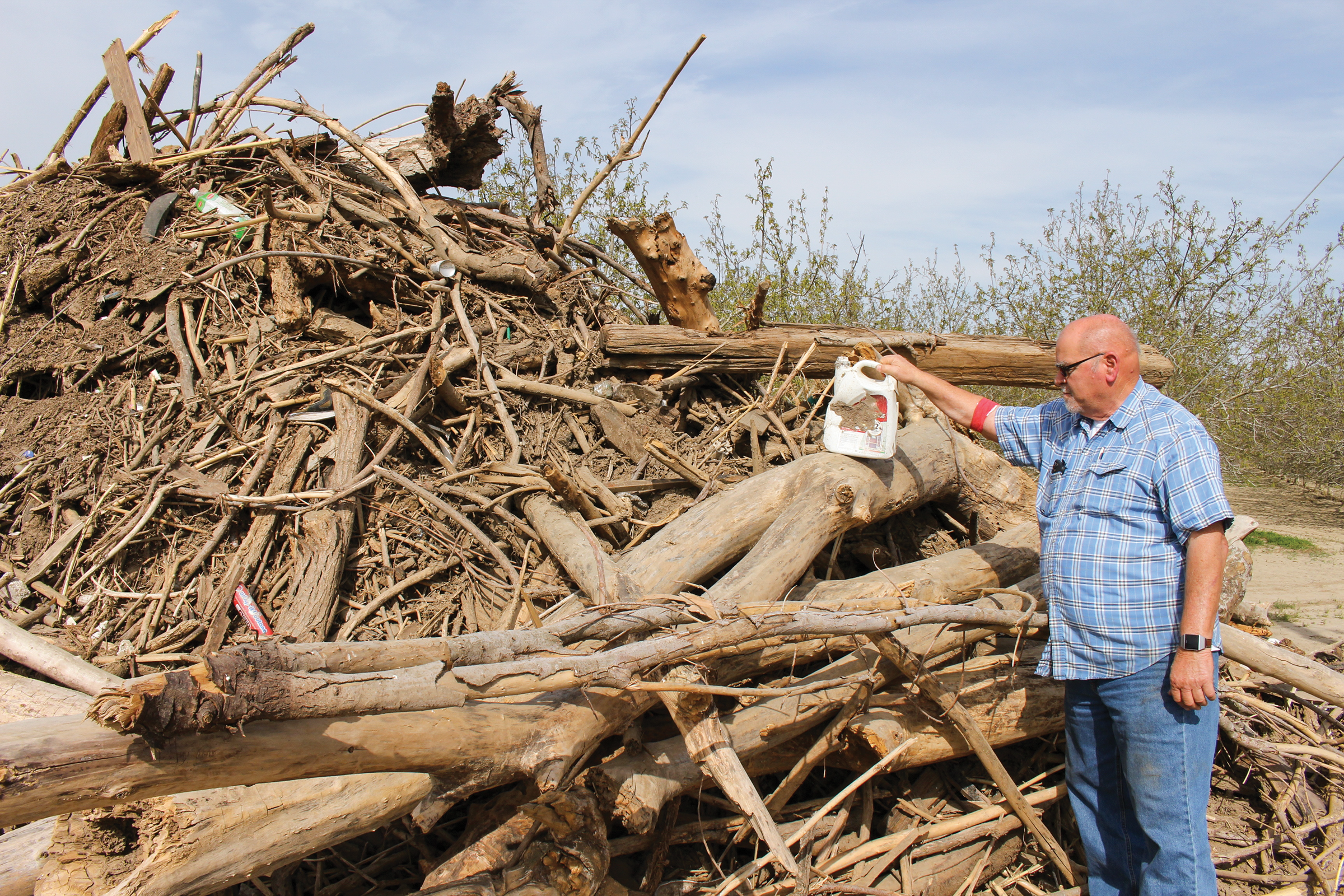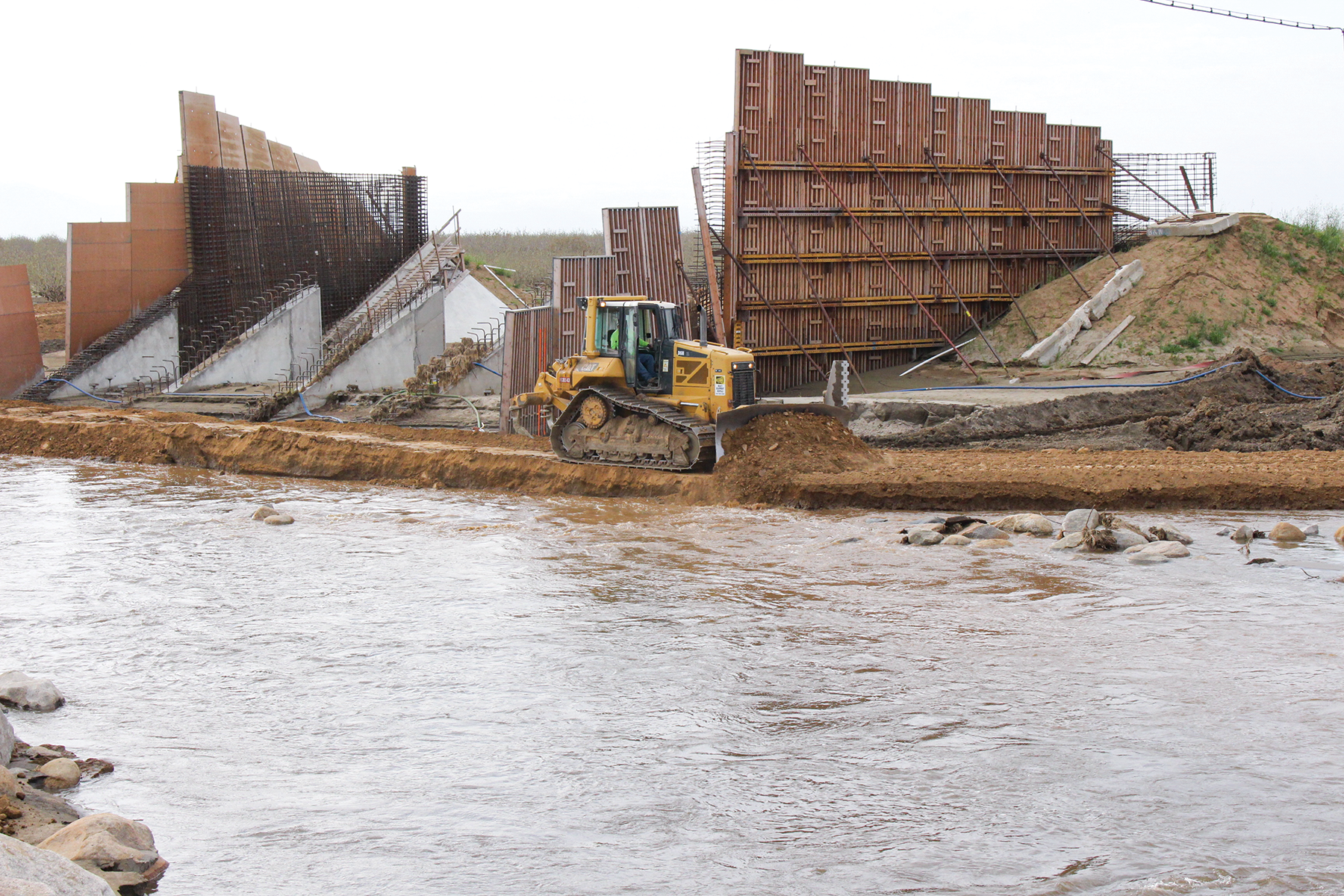Flood worries resume as snowpack melts

The onset of warm temperatures is accelerating snowmelt and triggering worries about continued flooding in the Central Valley from historic snowpack accumulated during winter and spring storms.

Tulare County dairy and citrus farmer Tom Barcellos takes stock of debris that he and others worked nonstop to clear from the Tule River, west of Porterville, to prevent further flooding and breaches. As temperatures warm, the state braces for more potential flooding during the spring and summer.
Photo/Christine Souza

Photo/Christine Souza
By Christine Souza
The onset of warm temperatures is accelerating snowmelt and triggering worries about continued flooding in the Central Valley from historic snowpack accumulated during winter and spring storms.
In Tulare County, farm fields have been inundated as floodwaters and, now, more rapidly melting snow fill lowlands of the former Tulare Lake.
Kings County Agricultural Commissioner Jimmy Hook said flooding impacts in the county have affected 64,000 acres, causing $131 million in financial losses. He said he expects damages to extend to 115,000 acres and losses to grow to $300 million by the end of snowmelt.
University of California Cooperative Extension farm advisors report that standing water has caused problems for feed crops, vegetables and tree crops in flood- affected counties.
Richard Matoian, president of American Pistachio Growers, said 2,500 acres of pistachios were underwater, according to an early estimate by his association.
“We’ve had some growers that have had levees break and had water and debris go through their fields and have since dried out and are in cleanup stage,” Matoian said. “We have people in and near the Tulare Lake bottom that continue to be flooded.”
More challenges may mount with snowmelt, said Tulare County Farm Bureau Executive Director Tricia Stever Blattler.
“We very much have ongoing concerns about snowmelt damage, so more flood damage is possibly on the forecast for several months,” she said. “This region is going to be in the 90s by the end of May and well into the 100s in June, and there’s a ton of snowpack up there.”
Water officials anticipate an abundance of water released through area rivers and creeks, which Blattler said are “already swollen and running fast and deep.” She added, “I imagine that some of the worst-hit dairies and farm businesses are trying to figure out where they might shore up levees that have already been breached.”
Jenny Fromm, water management chief at the U.S. Army Corps of Engineers, said officials expect to increase water releases from reservoirs in the Sacramento, San Joaquin and Tulare watersheds to create space for melting snow.
“The objective in managing the snowmelt is to release, over an extended period of time, a constant snowmelt flood release, in addition to the normal water supply release,” she said.
Many California counties were impacted in March and April by widespread flooding after rain and snowmelt overfilled rivers and creeks, displaced residents, washed out roads and damaged crops.
Gov. Gavin Newsom visited flood-affected areas in the Tulare Basin last week, including Hansen Ranches in Corcoran. The governor vowed to keep communities safe and announced that the state is working with the federal government to provide aid and support.
Eric Limas, general manager of the Tipton-based Lower Tule River Irrigation District, which covers more than 104,000 acres and has more than 150 miles of canals and rivers, said he does not anticipate additional flooding unless high temperatures persist.
He said state water officials expect as much as 250,000 acre-feet of runoff from the Tule River in Tulare County between April 1 and July 31. “If it comes off in the way that they are forecasting, we’ll be able to handle it without any further damage or flooding,” Limas said. “If we get a 10-day spell of 90 to 100 degrees and it stays hot, then potentially we could have some issues.”
During the past few weeks, Limas said, the district received help from contractors, farmers and Cal Fire to shore up washed out banks and levees, fill holes and remove tons of debris to keep water flowing through the system.
“We had farmers fixing things, we had the district fixing things, and we hired contractors. We haven’t got all of the bills yet, but we’re estimating somewhere around $1.5 million in damage and unexpected expenses,” Limas said.
Tom Barcellos, a dairy and citrus farmer in Tulare County, said he and others worked in shifts to address flooding in communities downstream of the Tule River and prevent further damage. But he said permanent fixes are needed, and debris must be cleared to help prevent additional breaches.
“A fair amount of the damage could have been avoided if we had been allowed to keep the channels clear,” said Barcellos, president of the Lower Tule River Irrigation District, which relies on water from the Tule River and the Friant-Kern Canal. “There are places with brush so heavy that as the water comes rushing by, it actually creates this vortex that starts eroding the banks, and debris gets hung up.”
To clear debris from a channel, Barcellos said, districts and agencies must apply to the state Department of Fish and Wildlife for a permit, a process that takes time and limits how much is removed. However, he said, the permit process was waived under the governor’s emergency declaration.
In the Tule River watershed near Terra Bella, significant flooding damaged construction happening at the middle reach of the Friant-Kern Canal, which delivers water to 1 million acres of farmland and more than 250,000 Californians from Fresno to Bakersfield. The site, now dry, was underwater a few weeks ago.
“Things are definitely out of whack just because of all the rain and water that came through here, and the breaching of the banks and all the sand and sediment that built up,” said David Dees, operations supervisor for the Friant Water Authority.
The Friant-Kern Canal, operated by the U.S. Bureau of Reclamation, has lost more than 60% of its original conveyance capacity in the middle section due to subsidence. “Right now, we can only push about 1,450 cubic feet per second through here. When the new canal is done, we’ll be able to push 2,500 cfs, so it’s a huge deal,” Dees said.
As water infrastructure repairs continue, farmers are waiting for standing floodwaters to seep into the ground so they can assess crop damage. Farmers who evacuated livestock, Barcellos said, have returned to their dairies and to damaged feed crops.
“Crop losses due to flooding and standing water are still being compiled,” he said. “For the ground that got flooded, they are trying to get the feed out and salvage what they can. We’re chopping feed and saving as much as we can and moving it to high ground.”
Matoian of American Pistachio Growers said the issue for pistachios and other permanent crops is standing water “effectively cuts off oxygen and the tree’s ability to transfer nutrients effectively up through the root system.”
“There’s still a lot of unknowns,” Matoian said, including whether snowmelt will lead to more flooding and damage.
To help farmers affected by flooding, Tulare County Farm Bureau, joined by the Tulare County Agricultural Commissioner and California Citrus Mutual, organized disaster assistance workshops. To learn more about aid in Tulare County, visit https://tularecounty.ca.gov/recovers/.
The U.S. Department of Agriculture Natural Resources Conservation Service in California announced $2 million in financial assistance to help state farmers recover from flooding. Deadline to apply is June 16. For information, contact NRCS service centers, which are listed at www.nrcs.usda.gov/contact/find-a-service-center.
(Christine Souza is an assistant editor of Ag Alert. She may be contacted at csouza@cfbf.com.)




